|
|
|
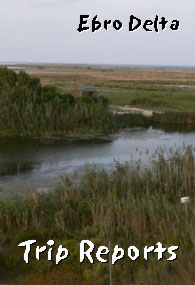 |
|
|
Site Details:


|
|
|
|
|
|
|
|
Trip reports from participants of Catalan Bird Tours' birding holidays and bird watching tours to THE EBRO DELTA will be posted here.
|
|
|
|
|
TRIP REPORTS:
|
|
|
|
|
|
|
|
|
|
|
|
|
|
|
|
|
|
|
|
|
For more Trip Reports:
|
|
|
|
|
|
|
|
|
|
|
|
|
|
|
|
|
|
|
|
|
|
|
|
|
|
|
|
|
|
|
|
|
|
|
|
Date
|
|
Author
|
|
Clients
|
|
|
|
|
|
|
|
|
|
|
|
|
|
|
|
|
|
|
|
|
|
|
|
|
|
20 october 2006
|
|
|
|
|
|
|
|
|
|
|
|
|
|
|
9th October 2006
|
|
Stephen Christopher
|
|
Darlene Moore, USA
|
|
|
Ebro Delta, Garraf Massif
|
|
|
|
|
|
|
|
|
|
|
|
|
|
|
|
|
|
|
|
|
"Incredibly Stephen was able to show me my most hoped for birds and much more. Being a birder who had only birded in the US, Stephen was patient and kind. His enthusaium and help with birding inspired me to register myself on Birdpal to help others who come to visit my home in Georgia.
My favorite birds were Bluethroat, the beautiful Lapwing, Hoopoe and the Wheatears. Thanks Stephen for everything, and the next time I come to Barcelona I hope to have either converted my husband or left him at home so we can bird for more than one day".
Darlene Moore, Georgia, USA
Apart from ‘everything’ Darlene had come all the way from the USA with only four birds on her wish list. One of them, a Bluethroat, gave us a disappointingly brief but nonetheless grateful viewing within seconds of arriving at the Gola de Migjorn on the Ebro Delta as it scuttled beneath the observation tower.
Greylag Geese, Merlin, Marsh Harrier, Great White Egret and a flock of twelve end-of-season Black-winged Stilt all stopped in by way of compensation but there was a distinct lack of ducks, soon explained by the sound of sustained gunshots.
So we headed off to the small reserve at Riet Vell, via a very sick Purple Heron, to discover a Water Rail skulking beneath the hide even as we made ourselves comfortable. A Kingfisher ventured past on numerous occasions whilst we were meanwhile entertained by Little and Great Crested Grebe, Reed Warblers and a Purple Gallinule or two stripping back the reed stems to feed on their more succulent centres.
On the approach to La Tancada we stopped to watch and photograph a Hoopoe, high on the list of anyone visiting from outside Europe, and accidentally stumbled upon a Whinchat with a pair of the closely related Stonechat. And whilst we were taking a moment to observe the numerous Crested and Skylarks flitting between the low vegetation here, a mid-distant view of a Northern Wheatear chalked up the second of Darlene’s ‘hoped for’ birds but better views were promised along the beach so we packed up to see if we could find one.
Actually several were in evidence and a flock of restful Audouin’s Gulls at the end of the beach road provided the penultimate species on the deviously short wish list. This area also donated three plovers to the day, the Kentish, Grey and Ringed, together with Ruddy Turnstone, the odd Mediterranean Gull and a flyby Common Tern.
Because of the relatively high water level, drowning out many of the lagoon edges used for feeding, waders and shorebirds were picked off one by one but in the end a handsome list boasted Little Stint, Dunlin, Snipe, Black-tailed Godwit, Spotted and Common Redshank, Greenshank, Common Sandpiper and (Pied) Avocet.
A last look over the lagoons revealed fishing Caspian and Sandwich Tern, Darlene’s (supposedly) final target bird, the Slender-billed Gull, and a supposed hybrid Little Egret x Western Reef Heron, which I managed to photograph rather badly.
At El Clot, as well as Flamingos, we found the missing ducks and amongst all the Red-crested Pochard we also picked out Gadwall, Shovelor and handful of Common Pochard. A few juvenile Black Tern swooped and dipped overhead and the reeds below offered great views of Cetti’s and Great Reed Warbler, the latter surely soon to depart for its wintering grounds in Africa.
Our outbound route from the delta took us past a small flock of Ruff hidden amongst a field of Lapwing and a stunning Osprey perched on a post by the river.
A good day in the Ebro Delta meant we arrived in the mountainous Garraf with barely two hours of daylight left so it’s a good job La Falconera is a great little spot. Incredibly we managed to line up almost the full party of usual suspects here and with no fleeting glances to boot. Our timely arrival coincided with dozens of Crag Martin coming in to roost whilst three equally active Black Wheatear pottered about at the base of the cliff, Blue Rock Thrush seemed to be everywhere and Black Redstart foraged on the beach. Add to that a flyover Grey Wagtail and a cursory scan of the cliff section overlooking the ocean revealed a Peregrine perched at the top and a lone Shag silently seated at the bottom.
Another reliable destination was nearby and, with farmland and adjacent woodland providing new habitats for the day, we still had a good chance to reach our real target of ‘everything’. At least three Hobby flying about catching dragonflies was a great start and Common Buzzard and Sparrowhawk quickly followed. Several migrants we’d seen on the Ebro Delta, such as Redstart and Whinchat, were evident here also but new ones included a few Swallows and a Common Whitethroat.
Blackcap, Jay and a small gathering of noisy Corn Bunting made up still more much appreciated new species for Darlene and we even had time for two final twilight additions, Dartford and Sardinian Warbler, in a scrub area on the way back to the airport.
We hadn’t quite seen ‘everything’ as Darlene had jokingly demanded but we’d had a pretty good try. A day I really enjoyed.
|
|
|
|
|
Slender-billed Gull
|
|
Hoopoe
|
|
|
|
|
|
|
|
|
|
|
|
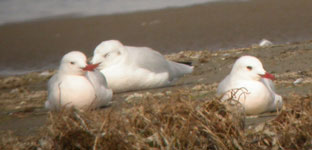 |
|
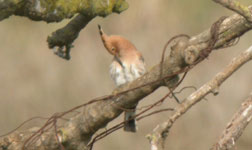 |
|
|
|
|
|
|
|
|
For a complete check list of this tour.

|
|
|
|
|
|
|
|
|
|
|
|
|
|
|
|
|
|
|
|
|
|
|
|
|
|
|
|
|
|
|
|
|
|
|
27 july 2006
|
|
|
|
|
|
|
|
|
|
|
|
|
|
|
|
27th September 2006
|
|
Stephen Christopher
|
|
Brian & Lucy Coleman, England
|
|
|
Ebro Delta, Pyrenees
|
|
|
|
|
|
|
|
|
|
|
|
|
|
|
|
|
|
|
|
|
|
“Thanks again for the excellent two days we birded together and the information you provided for the rest of my holiday. It was very useful to travel with a knowledgeable birder who understands the natural history of the birds and their distribution when visiting new areas and looking for specific species.
Both Lucy and I found both days nicely paced with plenty of variety and many opportunities to not just simply tick off the birds but to observe them as well.”
Brian and Lucy Coleman, England
A host of passing waders such as Black Winged Stilt, Ringed Plover, Little Stint, Dunlin, Ruff and Black-tailed Godwit were the target of our first early morning stop at a flooded rice field but they were gratefully upstaged by a surprising visit from a small group of over flying Honey Buzzard heading south.
Having moved on, we did likewise in the hope of adding to the excitement with some sought after Glossy Ibis. The ocean side platform overlooking La Gola de Migjorn is a good place to start and we were immediately rewarded with several flocks, both feeding in nearby fields and circling past the tower when they were startled into the air by the occasional gunshot. This sent the Purple Gallinules back into deep cover although a Bluethroat pottered about below us blissfully unaware. A Great Reed Warbler scuttled across a gap in the reeds somewhat more nervously and began what was to turn out to be a rather impressive list of warblers for the day.
Raptors also proved to be extremely accommodating with a light-phase Booted Eagle topping the morning off and a group of at least a dozen Marsh Harriers, including males, circling over an invisible spot in the mid-distance. Elsewhere Greylag Geese and Lapwing signalled the end of the summer and heron species included Squacco and several juvenile Night Heron.
The drive through the delta towards the reserve at Riet Vell revealed a lone Common Gull amongst a resting flock of Black-headed and Lesser Black-backed Gulls and a field full of Yellow Wagtails, all juveniles save a single adult flavissima, possibly from the UK.
Other migrant passerines included Redstart, Northern Wheatear and Spotted and Pied Flycatchers but a dispersing Southern Grey Shrike found amongst some old crates provided an unexpected bonus. Hoopoe and Kingfisher showed up to represent the exotics.
Yet another warbler, after we’d added Reed, Sardinian, Willow, Cetti’s and Fan-tailed, was a skulking Olivaceous Warbler in a line of tamarisk bushes near the Baladres water pump. And, on the open ground opposite, we even trailed a pair of Spectacled Warbler before we headed off to scan the lagoons at La Tancada.
Fishing Caspian Terns were immediately apparent diving between the throngs of Coot and ducks (inc. Red-crested and Common Pochard) but we also picked out the odd passing Slender-billed Gull. More of these materialised in the beach area along with Mediterranean and Little Gulls. Here also we added to the shorebirds with Grey and Kentish Plovers and Avocet, Sanderling, Curlew, Greenshank, Spotted Redshank and Green Sandpiper were all present in another section of La Tancada.
This area played host to many juvenile terns including Sandwich, Whiskered and Black but its parting gift was an absolutely wonderful Osprey, which lazed its way back and forth over the shallows in search of a snack before moving off itself.
|
|
|
|
|
|
Great White Egret
|
|
Squacco Heron
|
|
Flamingo and Black-tailed Godwits
|
|
|
|
|
|
|
|
|
|
|
|
 |
|
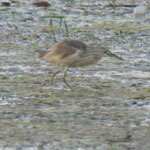 |
|
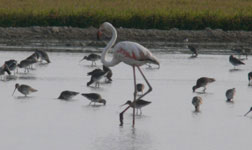 |
|
|
|
|
To see part two of he Coleman's Trip, to the Pyrenees,

|
|
|
|
For a complete check list of this tour.

|
|
|
|
|
|
|
|
|
|
|
|
|
|
|
|
|
|
|
|
|
|
|
|
|
|
|
|
|
|
|
|
|
|
|
17 february 2006
|
|
|
|
|
|
|
|
|
|
|
|
|
|
|
|
10 July 2006
|
|
Stephen Christopher
|
|
Ian Moig, Scotland
|
|
|
Ebro Delta, Pyrenees
|
|
|
|
|
|
|
|
|
|
|
|
|
|
|
|
|
|
|
|
|
|
"Once again thank you for two terrific days birding."
Ian Moig, Scotland
Listening to tales of Nightjars and other amazing birds visiting Ian on his oil rig in the middle of the North Sea, it felt more like going birding with an old friend as we headed for the Ebro Delta from his pick-up point at the Portaventura resort, especially as we’d already had a fantastic day in the Pyrenees a few days earlier.
In the months running up to today we’d swapped emails comparing the onset of spring and the arrival of migrants in our respective latitudes and, as we watched the bustling early morning activities around the lagoon at L’Encanyissada, the relative lateness of the summer here was clearly in evidence. Red-crested Pochards, hundreds of them, were now all in their moulting eclipse phase, the Spanish sub-species of Yellow Wagtail (iberiae) all seemed to be juveniles and small family gatherings of birds such as Zitting Cisticola and Little Bittern flitted and played amongst the reeds.
In fact most species had juvenile representatives. As the sun rose and the cool morning continued to awaken, Common and Whiskered Terns, both with varying degrees of black plumage patterns, hawked and hovered over the shallows in front of us and seemed to take turns on the single resting post on the water’s edge. Far out, flocks of wading Greater Flamingoes, some pink some grey-white, bowed their heads and began to take the day’s first feed whilst a nervous Water Rail skipped across a nearby clearing.
Moving on, along a water channel between reed beds and flooded paddy fields, we accidentally persuaded several imperial Purple Herons to take to the skies, one of which caused the same course of action to domino across a flock of pip-squealing Black-winged Stilt. A bold Purple Gallinule didn’t seem to mind us too much however and a lone Savi’s Warbler didn’t even notice us as, with bated-breath, we watched it for several minutes gleaning a morning meal just one metre in front of the hide window.
Squacco Heron, Night Heron and Great White Egret helped us to a total of eight heron species before we reached La Tancada, where we increased the variety of terns to six with Sandwich, Little, Gull-billed and one or two Caspian Terns. A single Whimbrel topped an impressive list of shorebirds, which also included the closely related Curlew as well as Black-tailed Godwit and Kentish and Grey Plovers.
A much-needed rest from the rising temperature facilitated a much-deserved lunch in the hide at Riet Vell, where we munched and chewed our way through Glossy Ibis, Great Reed Warbler, Sand Martin, Common Pochard, a preening Kingfisher and the scarce Spanish sub-species of Reed Bunting, witherbyi.
Mediterranean, Audouin’s and Slender-billed Gulls provided other highlights of the day, which we concluded with some lark practise – made necessary by more tricky juveniles – with Crested, Short-toed and Skylark all volunteering to help.
|
|
|
|
|
|
Whiskered Tern
|
|
Dunlin
|
|
Whimbrel
|
|
|
|
|
|
|
|
|
|
|
|
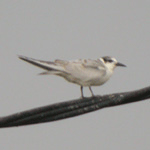 |
|
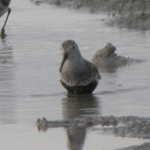 |
|
 |
|
|
|
|
To see part two of he Moig's Trip, to the Pyrenees,

|
|
|
|
For a complete check list of this tour.

|
|
|
|
|
|
|
|
|
|
|
|
|
|
|
|
|
|
|
|
|
|
|
|
|
|
|
|
|
|
|
|
|
|
|
|
|
|
|
|
|
|
|
|
|
|
|
|
|
|
|
28th June 2006
|
|
Stephen Christopher
|
|
Matias Castren
|
|
|
Ebro Delta
|
|
|
|
|
|
|
|
|
|
|
|
|
|
|
|
|
|
|
|
|
|
“I can highly recommend both the tour we made and Stephen, as a guide.
All sites visited provided different and interesting species, especially the amount of herons was enjoyable. I enjoyed the day a lot... and also the lunch tasted excellent.”
Matias, Finland
Matias and I spent the short journey from his pick-up at the Tres Calas resort to the Ebro Delta discussing the target list he’d sent me. It contained twenty-four species that were present at this time of year but, having had limited experience in southern Europe, he was also keen to see whatever else this warm June day had to offer.
Rather amazingly, as it turned out, it made its first and arguably best donation within minutes of our arrival. Whilst picking off the early morning feeders in and around the L’Encanyissada lagoon (Great Crested Grebe, Black-winged Stilt, Purple Gallinule, Purple Heron and several Little Bittern playing hide and seek) a re-scan of the hundreds of Common Coot revealed a single Red-nobbed Coot within their midst.
From then on it may have been business as usual for the Ebro, throwing up a ‘no-surprises’ package of Warblers (Cetti’s, Fan-tailed, Reed, Great Reed and Sardinian), Gulls (Audouin’s, Slender-billed, Mediterranean and Yellow-legged) and Terns (Caspian, Gull-billed, Whiskered, Little and Common) but, for Matias, many of these were lifers and he was given the chance to sit and watch them at close quarters.
Slowly but surely we worked our way through them. After several roadside Squacco Herons, a startlingly close adult Night Heron perched in a tree completed his heron list. Spotless Starling proved an easy tick for the day, and Crested and Short-toed Larks paid a simultaneous visit on the road between La Tancada and Riet Vell. The latter is a relatively recent addition to the Delta and here, over lunch, we enjoyed the ‘non-listed’ Great White Egret, Sand Martin, Cuckoo, Hoopoe and Red-crested Pochard, very few of which were still in breeding plumage even at this early stage of the summer.
Despite missing out on a few of his target birds, such as the Shearwaters as the tourist-filled beaches made sea-watching unprofitable, a Spanish Yellow Wagtail (sub-species iberiae) provided another unexpected bonus for Matias (along with the Red-nobbed Coot we’d seen earlier).
But there was one bird that was high on his list and had so far at least avoided us so we headed back to La Tancada, an area where we had previously seen Kentish Plover, Redshank, Pied Avocet and Dunlin, for one final attempt. And finally, after spotting one of the Ebro’s few summering but non-breeding Curlew, a Collared Pratincole flew straight over the car and we watched it disappear into the distance.
Back in Tres Calas, I left Matias with a few tips on where to find some of the other species he wanted, including a recommended trip to nearby Les Ports, and wished him good luck for the rest of his holiday.
|
|
|
|
|
|
Pied Avocets
|
|
Squacco Heron
|
|
|
|
|
|
|
|
|
|
|
|
 |
|
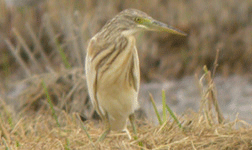 |
|
|
|
|
|
|
|
|
For a complete check list of this tour.

|
|
|
|
|
|
|
|
|
|
|
|
|
|
|
|
|
|
|
|
|
|
|
|
|
|
|
|
|
|
|
|
|
|
|
|
|
|
|
|
|
|
|
|
|
|
|
|
|
|
|
10 April 2006
|
|
Stephen Christopher
|
|
Jan, Jeff and Clare O'Brien, Canada
|
|
|
Ebro Delta
|
|
|
|
|
|
|
|
|
|
|
|
|
|
|
|
|
|
|
|
|
|
“Thank you again for the incredible trip to the Ebro Delta. It was a great day from start to finish. We really appreciated your superb bird spotting abilities and you make a wonderful picnic. That day was the highlight of my trip to Barcelona. I can’t get over how many new birds we saw.”
Jan O’Brien, Canada
Well over an hour later than arranged, I was surprised to see Jan O’Brien, with husband and daughter, Jeff and Clare, suddenly coming towards me from my right. Surprised because the exit from the train station, which I’d been avidly hawking since just before dawn, was to my left. And surprised because, as if nothing had happened and eager to start, all three stomped towards me smiling brightly and with eyes-alight.
I smiled back instantly of course, partly because of the contagiousness of this healthy attitude to life but also, I confess, because of their blissful unawareness of a delicious irony. Here we were, about to disembark on a quest to seek out just a few of the astounding number of birds who instinctively navigate their way over thousands of kilometres to The Ebro Delta, and my clients get lost in the first fifteen metres from the train station to the car park! Mind you, to be fair, they had just flown all the way from Canada.
Its amazing how these little things set the tone for the day and, as I helped them load the back of the car with enough luggage to mount a campaign to the peak of Everest, I was already looking forward to the day ahead with eager anticipation.
Some of the aforementioned migrants, including the Black-winged Stilt and Purple and Squacco Herons that we saw, seek the reed beds and rice fields of the Delta de L’Ebre, to give it its Catalan name, as their final destination but others, such as many of the waders and shorebirds listed below, very few of whom actually breed here, use them and the acres of marshes only as a stopover.
Despite the wind, which kept many passerines low and out of sight, it was indeed a good day for such birds as they time their journey perfectly to coincide with man’s deliberate flooding of the area, taking advantage of the many mud-caked banquets appearing along the edges of its paddy fields and water channels. Throughout the day we encountered Wood and Common Sandpiper, Curlew, Pied Avocet, Little Stint, Sanderling, Dunlin, Greenshank, both Spotted and Common Redshank, a few Snipe not yet having left following their winter stay, and Ringed, Kentish and Grey Plover.
For a few moments we seemed to be part of one bird’s journey as a stunning black-bellied Whiskered Tern decided to join us as we drove our way to La Tancada, floating and ‘rowing’ alongside the passenger window. We got a rare chance to see a Bonelli’s Warbler, my first of the year, out in the open as it sipped water from the edge of an irrigation channel and witnessed a rather bizarre mating ritual as two male Crested Larks, ignoring our accidental encroach into their space, focussed single-mindedly on the task of seducing a lone female.
No sign of the Hoopoe that was high on the wish list, but a spring-fresh male Northern Wheatear was greeted with glee by my trans-Atlantic travellers and other favourites included the extremely rare Audouin’s Gull and the surely-not-from-this-world Purple Gallinule.
As I drove them back up the motorway and all three, induced by strong winds and long hours, had succumbed to heavy eyelids, a Hoopoe paddled over the carriageway in front of us. ‘Look!’ I shouted, scaring the hell out of all three of them. ‘Ooo!’ came back the response as surely as if I’d set off a firework. But a few moments later they’d faded again, as had the light, and I was left to ponder and drive, inspired to be honest, by the interest such a young and charming teenager like Clare took in nature.
I also pondered on the travels ahead of them. Clare, temporarily off to join her sister’s new life in England, via Germany, and her parents back to theirs in Canada, via England. I just hoped they didn’t get lost!
|
|
|
|
|
|
Curlew
|
|
A great place for crakes (and picnics!)
|
|
|
|
|
|
|
|
|
|
|
|
 |
|
 |
|
|
|
|
|
|
|
|
For a complete check list of this tour.

|
|
|
|
|
|
|
|
|
|
|
|
|
|
|
|
|
|
|
|
|
|
|
|
|
|
|
|
|
|
|
|
|
|
|
|
|
|
|
|
|
|
|
|
|
|
|













